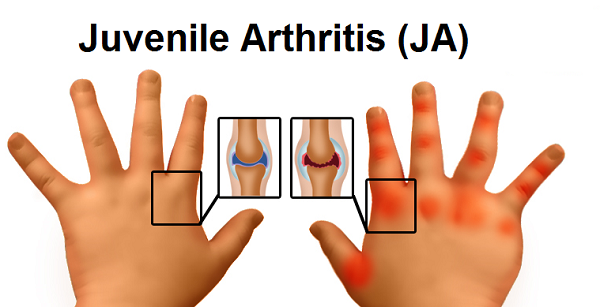What Is Arthritis?
Juvenile arthritis. Is there arthritis in juveniles? What’s the aggressive treatment for juvenile arthritis? Growing pains cause a child to feel joint aches. However, they may be early signs of severe inflammatory rheumatic diseases called pediatric arthritis or arthritis in juveniles.
Moreover, juvenile arthritis affects children and adolescents and can take various forms, including Polyarticular Juvenile Idiopathic Arthritis (JIA) and Systemic JIA. These conditions involve inflammation in the joints, which can lead to pain and stiffness. Some forms of juvenile arthritis may also affect internal organs and involve skin disease. While rheumatoid factor is often used to diagnose adult arthritis, it is less reliable for diagnosing juvenile arthritis. The Arthritis Foundation provides resources and support for families dealing with both arthritis and various treatments that can help relieve pain in the joints involved.
Arthritis in juveniles is an autoimmune disease. The body’s healthy cells attack most children younger than you can imagine. They may encounter this condition in their teenage years or possibly younger.
What is involved in this auto-immune condition? How does the condition affects the immune system and cause chronic arthritis?
Juvenile Idiopathic Arthritis
Arthritis involving chronic or long-term joint inflammation and persistent joint pain falls under systemic types of juvenile idiopathic arthritis (JIA) or juvenile arthritis. This inflammation begins before patients reach the age of 16. For juvenile idiopathic arthritis to be considered chronic, joint symptoms must be present for more than six weeks. Juvenile idiopathic arthritis can cause other symptoms like fevers or pink rash on the skin, and it can also cause eye inflammation.

It Causes Growth Problems And Needs Immediate Medical Attention.
It happens when the immune system assaults the tissue lining inside the stiff joints called synovium, which causes joint pain, joint stiffness, and joint inflammation or swelling. In some cases, children would only have one or two flare-ups, while others will have symptoms for a lifetime.
Juvenile arthritis is a group of diseases that affects children with JIA. Polyarticular JIA affects multiple joints, while oligoarticular JIA affects fewer joints. Symptoms of juvenile arthritis can vary, but regular exercise can help alleviate pain and stiffness. Many children with JIA may also have a skin condition in addition to joint inflammation.
Doctor’s Diagnosis Of Juvenile Arthritis Disease
Unlike adult rheumatoid arthritis, Juvenile idiopathic arthritis is complex, making diagnosis difficult. Doctors may order various lab tests, including a physical exam, blood tests, x-rays, and urine tests, which can help determine conditions that may cause natural arthritis. Early diagnosis, medication, and treatment can reduce inflammation, reduce pain, and joint damage and help maintain body movement. It can also prevent any cases of severe complications or replacement of affected joints.
In juvenile arthritis, the body attacks its healthy cells, affecting the joints. While it can have similar symptoms to the adult form of arthritis, it may also affect children in different ways. A family history of autoimmune diseases can increase the risk of developing different types of juvenile arthritis, and some severe forms of the condition may require a blood test for diagnosis. Juvenile arthritis can be a lifelong disease, but early detection and proper treatment can help manage symptoms and improve quality of life.
Five Types And Different Prognosis of Arthritis
Enthesitis-Related Arthritis Disease
- It is a type of JA that affects the eyes, entheses, hips, spine, and places where tendons are attached to the bones. It occurs mostly in boys eight years and older with a family medical history of ankylosing spondylitis among their male relatives.
Systemic Disease
- It is also known as Still’s disease, and it affects numerous body systems such as the heart, liver, lymph nodes, and spleen, aside from joint problems. This type of arthritis exact causes a high fever and rashes on the arms, legs, and trunk.
Polyarticular Juvenile Idiopathic Arthritis (PJIA) Disease
- This type of arthritis affects five or more joints during the first half-year of the disease, which is usually the jaw, neck, hands, and feet. It often occurs in the left and right joints of the body symmetrically. It is more common for girls to develop this disorder than boys.
Oligoarthritis Disease
- This disorder is also known as periarticular juvenile rheumatoid arthritis. It affects the ankle, knee, and wrist. Additionally, this type of arthritis may cause issues to the iris of the eye known as iridocyclitis, iritis, or uveitis. Girls are more prone to developing this disorder but will outgrow the disease in adulthood.
Psoriatic Arthritis Disease
- It affects children who are suffering from both psoriasis and arthritis. The symptoms usually start with either psoriasis or arthritis in juveniles before developing the others years later.

Juvenile Arthritis
Treatment And Medication For Children Who Have This Particular Disease
Children who have arthritis need treatment from pediatric rheumatologists who undergo specialized training to mitigate the disease.
Medication is one of the essential parts of treating arthritis in children, which may take several years until arthritis maintains an inactive status. The treatments for this arthritis disease aim to reduce joint swelling and relieve symptoms of pain, retaining the ability to do daily functions. The treatment will help the child’s quality of life.
But to treat adults’ conditions, the common form of treatment goal is to control symptoms, prevent joint damage, and maintain function.
When only a few joints are involved, a steroid can be injected into the joint before any additional nonsteroidal anti-inflammatory drugs are given.
Steroids injected into the joint do not have significant side effects. Oral steroids such as prednisone (Deltasone, Orasone, Prelone, Orapred) may be used in certain situations, but only for a short time and at the lowest dose possible. The long-term use of steroids is associated with side effects such as weight gain, poor growth, osteoporosis, cataracts, avascular necrosis, hypertension, and risk of infection.
Create Awareness For This Disease
The therapy involves treating, identifying, and preventing complications that a juvenile’s arthritis may bring, such as soft tissue damage and other joint-related problems. Parents should also be aware of their child’s arthritis and their well-being.
If parents are unsure about their symptoms, getting help to develop juvenile arthritis awareness is better.
You can try and visit https://www.betterhelp.com/ for more information you might need.
Frequently Asked Questions
What Can Trigger Juvenile Arthritis?
Juvenile arthritis can be triggered by various diseases, conditions, or disease-modifying factors.
Does Juvenile Arthritis Go Away?
Juvenile arthritis, the common type of rheumatic disease in children, may not always go away and can involve symptoms like eye inflammation and swollen lymph nodes.
How Do I Know If I Have Juvenile Arthritis?
Common signs of juvenile idiopathic arthritis include joint pain and swelling, and if you suspect it, consult a health professional for diagnosis.
Which Of The Signs Of Juvenile Rheumatoid Arthritis Is The Earliest?
Is JRA Serious?
At What Age Does Juvenile Arthritis Start?
How Serious Is Juvenile Arthritis?
Is JRA Hereditary?
Is Juvenile Arthritis Painful?
Does Juvenile Arthritis Show Up On An X-ray?
